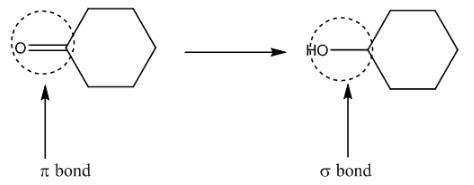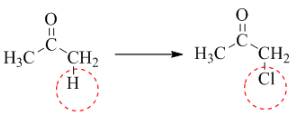
Concept explainers
(a)
Interpretation: The given transformation is to be classified as substitution, elimination, or addition reaction.
Concept introduction: The substitution reactions involve the substitution or replacement of an atom or group of atoms in a compound by another atom or groups of atoms. In the substitution reactions, the replacement takes place by the break down of sigma bonds.
In elimination reaction, the formation of
Answer to Problem 6.1P
The given transformation is an example of a substitution reaction.
Explanation of Solution
The given transformation is shown as,

Figure 1
In the above reaction, the hydroxyl group is replaced by a bromine atom. The breakdown of the sigma bond precedes the mechanism. On replacement of the hydroxyl group, one sigma bond breaks and another is formed at the same position. Therefore, it is classified as the substitution reaction.
The given transformation is classified as a substitution reaction.
(b)
Interpretation: The given transformation is to be classified as substitution, elimination, or addition reaction.
Concept introduction: The substitution reactions involve the substitution or replacement of an atom or group of atoms in a compound by another atom or groups of atoms. In the substitution reactions, the replacement takes place by the break down of sigma bonds.
In elimination reaction, the formation of
Answer to Problem 6.1P
The given transformation is an example of an addition reaction.
Explanation of Solution
The given transformation is shown as,

Figure 2
The above reaction involves the breakdown of
The given transformation is classified as an addition reaction.
(c)
Interpretation: The given transformation is to be classified as substitution, elimination, or addition.
Concept introduction: The substitution reactions involve the substitution or replacement of an atom or group of atoms in a compound by another atom or groups of atoms. In the substitution reactions, the replacement takes place by the break down of sigma bonds.
In elimination reaction, the formation of
Answer to Problem 6.1P
The given transformation is an example of a substitution reaction.
Explanation of Solution
The given transformation is shown as,

Figure 3
In the above reaction, the hydrogen is replaced by chlorine. The breakdown of the sigma bond precedes the mechanism. On the replacement of hydrogen, one sigma bond breaks and another sigma bond is formed between carbon and substituent atom.
The given transformation is classified as a substitution reaction.
(d)
Interpretation: The given transformation as substitution, elimination, or addition is to be classified.
Concept introduction: The substitution reactions involve the substitution or replacement of an atom or group of atoms in a compound by another atom or groups of atoms. In the substitution reactions, the replacement takes place by the break down of sigma bonds.
In elimination reaction, the formation of
Answer to Problem 6.1P
The given transformation is an example of an elimination reaction.
Explanation of Solution
The given transformation is shown as,

Figure 4
In this reaction, the formation of
The given transformation is classified as an elimination reaction.
Want to see more full solutions like this?
Chapter 6 Solutions
Organic Chemistry
- Synthesize 2-Ethyl-3-methyloxirane from dimethyl(propyl)sulfonium iodide using the necessary organic or inorganic reagents. Draw the structures of the compounds.arrow_forwardSynthesize 2-Hydroxy-2-phenylacetonitrile from phenylmethanol using the necessary organic or inorganic reagents. Draw the structures of the compounds.arrow_forwardSynthesize N-Methylcyclohexylamine from cyclohexanol using the necessary organic or inorganic reagents. Draw the structures of the compounds.arrow_forward
- Synthesize N-Methylcyclohexylamine from cyclohexanol using the necessary organic or inorganic reagents. Draw the structures of the compounds.arrow_forwardIf possible, please provide the formula of the compound 3,3-dimethylbut-2-enal.arrow_forwardSynthesize 1,4-dibromobenzene from acetanilide (N-phenylacetamide) using the necessary organic or inorganic reagents. Draw the structures of the compounds.arrow_forward
- Indicate the products obtained by mixing (3-oxo-3-phenylpropyl)triphenylphosphonium bromide with sodium hydride.arrow_forwardWe mix N-ethyl-2-hexanamine with excess methyl iodide and followed by heating with aqueous Ag2O. Indicate the major products obtained.arrow_forwardIndicate the products obtained by mixing acetophenone with iodine and NaOH.arrow_forward
- Indicate the products obtained by mixing 2-Propanone and ethyllithium and performing a subsequent acid hydrolysis.arrow_forwardIndicate the products obtained if (E)-2-butenal and 3-oxo-butanenitrile are mixed with sodium ethoxide in ethanol.arrow_forwardQuestion 3 (4 points), Draw a full arrow-pushing mechanism for the following reaction Please draw all structures clearly. Note that this intramolecular cyclization is analogous to the mechanism for halohydrin formation. COH Br + HBr Brarrow_forward
 Organic Chemistry: A Guided InquiryChemistryISBN:9780618974122Author:Andrei StraumanisPublisher:Cengage Learning
Organic Chemistry: A Guided InquiryChemistryISBN:9780618974122Author:Andrei StraumanisPublisher:Cengage Learning
